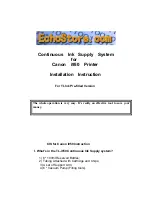
alert. If you switch off Overspeed alerts you will hear the normal warning for each alert, but
you will not be notified if you exceed the speed limit when approaching a database location.
Overspeed alerts work with Continuous overspeed warning and Alert speed tolerance to
fine tune how you want your C550 to operate.
6 Variable Warning Distance
Variable warning distance automatically reduces the alert distance at slower speeds.
7 Alert speed tolerance
The Alert speed tolerance allows you to increase the alert activation speed to an amount
above the speed limit.
For example, if you select 10%, you will not receive any overspeed warnings until you are
more than 10% above the speed limit.
Alert speed tolerance also works with Whisper mode, but Point to point speed camera
zones are excluded from this feature.
8 Continuous overspeed warning
Continuous overspeed warning controls the frequency of overspeed alerts.
Switching On will give an overspeed alert regularly when you are over the limit.
Switching Off means the overspeed alert will beep just 1 time and then 1 more time if you
exceed the limit during the alert. There will be a second reminder beep 75m from the stored
location if you are still driving over the limit.
9 Heads-up chime
This controls the alert’s initial heads-up chime. This is the beep that plays at the start of an alert.
10 Pass chime
This controls the confirmation chime as you pass the alert location.
11
We recommend that you also switch on Variable warning distance, which automatically
reduces the alert distance at slower speeds.
Types of alert and options:
- Speed cameras
- Stored mobile cameras and mobile zones
- Point to point speed cameras and zones
- Point to point exits
- Safety locations
- School zones
- Information locations
Stored mobile cameras are locations where mobile cameras are often seen. The C550 is
not a radar or laser detector, so it will not “detect” a live radar or laser gun. Safety locations
are used where it’s good to have some advance warning of nearby cameras, but you
wouldn’t receive a ticket in your direction of travel. For example, if there is one red light
camera at a 4 way junction, the 3 non-enforced directions would be Safety locations so you
are aware there is an issue with red light running in another direction. Information locations
are used where it’s good to have some advance warning of areas where you may want to
pay extra attention, such as dangerous curves. Non-ticketing cameras are cameras that
do not issue fines. Opposite direction alerts are warnings when you are driving towards
an active camera, but could not receive a fine from the camera in your direction of travel.
Highway cameras describe cameras on faster roads.
Important note on point to point zones:
During a point to point speed zone, your average
speed is calculated from the start of the zone to your current location. If the zone is very
long, your average speed may be calculated between any camera or group of cameras, it
would be possible to have a low average speed overall, but have a high average speed
between any two points, so it’s important to always remain within the speed limit.
5 Overspeed alerts
Overspeed alerts are beeps that will be heard if you remain above the speed limit when
approaching a database location. You can choose to switch these on and off for each type of
- Red light cameras
- Non-ticketing cameras
- Cameras in tunnel
- Personal locations
- Opposite direction alerts
- Highway cameras
10



























